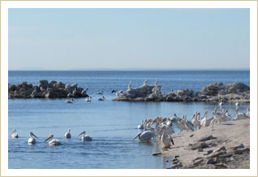Visitor Information
Welcome to the Visitor Information page. Here you will find facts about the Salton Sea, information about the State Park and the National Wildlife Refuge, Visitor Centers information and more. If you have any questions, please feel free to contact us.Salton Sea Facts and Information

The Salton Sea is the most recent form of Lake Cahuilla: an ancient lake that’s cyclically formed over the centuries due to natural flooding from the Colorado River. The current Salton Sea was created in 1905 when Colorado River floodwaters breached an irrigation canal near Yuma and flowed into the Salton Sink. The sea managed to retain its form into the late 90s it continued to receive water in the form of irrigation runoff through the New and Alamo rivers. This sea in the desert became a favorite getaway for Hollywood stars and was eventually stocked with fresh and saltwater sports fish to entice anglers.
Since its initial flooding in the 20th century, the Salton Sea has attracted a tremendous diversity of birdlife, drawn by the mix of saltwater and freshwater habitats and marshes. Migratory birds traveling along the Pacific Flyway have sought out this wetland oasis to refuel before continuing south. The sea has been a winter home for more than 90 percent of the western population of American White Pelicans and has hosted millions of eared grebes during their southward migration. On the refuge and in the immediate surrounding area, over 400 species of birds have been documented. Currently, the sea provides habitat to hundreds of thousands of different species of shorebirds, waterfowl, and gulls during the winter season.
Over time, the Salton Sea has shrunk in size, in parts because of the natural evaporation of water in the hot desert, and because of changing farming practices. As farmers switch from flood irrigation to sprinkler irrigation, less water is being run off into the Salton Sea and more water is being supplied to major cities through southern California.
Because the sea is a terminal lake, it has also grown saltier. The sea is now more than twice as salty as the Pacific Ocean and is losing its ability to sustain the fish and organisms that are essential food for migrating birds. Currently, birds along the edge of the Salton Sea forage on the water boatman bug and biofilm that still thrive in the Salty ecosystem, while other species of birds can be seen flocking around the edges of the sea where the irrigation drains and rivers pour in. Efforts to address the restoration of the Salton Sea have been in process for many years and will continue for many more. Some of the bigger restoration efforts visitors can see along the southern edge of the Salton Sea are the State SCH Project and Audubon’s Bombay Beach.


